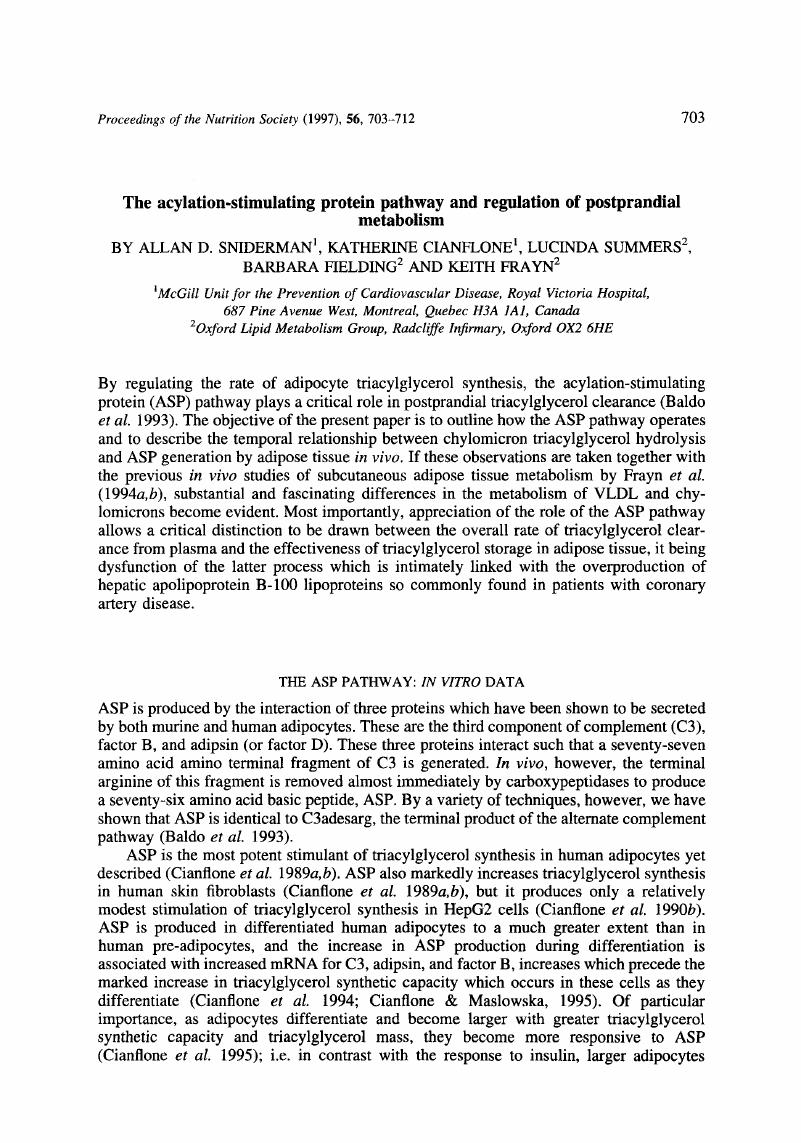Crossref Citations
This article has been cited by the following publications. This list is generated based on data provided by Crossref.
Williams, Christine M.
1997.
Postprandial lipid metabolism: effects of dietary fatty acids.
Proceedings of the Nutrition Society,
Vol. 56,
Issue. 2,
p.
679.
Frayn, Keith N.
Summers, Lucinda K. M.
and
Fielding, Barbara A.
1997.
Regulation of the plasma non-esterified fatty acid concentration in the postprandial state.
Proceedings of the Nutrition Society,
Vol. 56,
Issue. 2,
p.
713.
Frayn, Keith N.
1998.
Skeletal Muscle Metabolism in Exercise and Diabetes.
Vol. 441,
Issue. ,
p.
171.
Frayn, Keith N.
1998.
Non-esterified fatty acid metabolism and postprandial lipaemia.
Atherosclerosis,
Vol. 141,
Issue. ,
p.
S41.
GREGOIRE, FRANCINE M.
SMAS, CYNTHIA M.
and
SUL, HEI SOOK
1998.
Understanding Adipocyte Differentiation.
Physiological Reviews,
Vol. 78,
Issue. 3,
p.
783.
Summers, Lucinda K.M.
Fielding, Barbara A.
Herd, Sara L.
Ilic, Vera
Clark, Mo L.
Quinlan, Paul T.
and
Frayn, Keith N.
1999.
Use of structured triacylglycerols containing predominantly stearic and oleic acids to probe early events in metabolic processing of dietary fat.
Journal of Lipid Research,
Vol. 40,
Issue. 10,
p.
1890.
Weyer, Christian
and
Pratley, Richard E.
1999.
Fasting and Postprandial Plasma Concentrations of Acylation‐Stimulation Protein (ASP) in Lean and Obese Pima Indians Compared to Caucasians.
Obesity Research,
Vol. 7,
Issue. 5,
p.
444.
Wetsel, Rick A.
Kildsgaard, Jens
Zsigmond, Eva
Liao, Wei
and
Chan, Lawrence
1999.
Genetic Deficiency of Acylation Stimulating Protein (ASP(C3ades-Arg)) Does Not Cause Hyperapobetalipoproteinemia in Mice.
Journal of Biological Chemistry,
Vol. 274,
Issue. 27,
p.
19429.
Frayn, Keith N.
1999.
Macronutrient metabolism of adipose tissue at rest and during exercise: a methodological viewpoint.
Proceedings of the Nutrition Society,
Vol. 58,
Issue. 4,
p.
877.
Kildsgaard, Jens
Zsigmond, Eva
Chan, Lawrence
and
Wetsel, Rick A
1999.
A critical evaluation of the putative role of C3adesArg (ASP) in lipid metabolism and hyperapobetalipoproteinemia.
Molecular Immunology,
Vol. 36,
Issue. 13-14,
p.
869.
Inui, Akio
2000.
Transgenic Approach to the Study of Body Weight Regulation.
Pharmacological Reviews,
Vol. 52,
Issue. 1,
p.
35.
Berraondo, Beatriz
and
Martínez, J. Alfredo
2000.
Free Fatty Acids Are Involved in the Inverse Relationship between Hormone‐Sensitive Lipase (HSL) Activity and Expression in Adipose Tissue after High‐Fat Feeding or β3‐Adrenergic Stimulation.
Obesity Research,
Vol. 8,
Issue. 3,
p.
255.
Vidal, Hubert
2001.
Gene expression in visceral and subcutaneous adipose tissues.
Annals of Medicine,
Vol. 33,
Issue. 8,
p.
547.
Frayn, Keith N.
2001.
Adipose tissue and the insulin resistance syndrome.
Proceedings of the Nutrition Society,
Vol. 60,
Issue. 3,
p.
375.
Martínez De Morentin, B.E.
Rodríguez, M.C.
and
Martínez, J.A.
2003.
Síndrome metabólico, resistencia a la insulina y metabolismo tisular.
Endocrinología y Nutrición,
Vol. 50,
Issue. 8,
p.
324.
Frayn, Keith N.
and
Blaak, Ellen E.
2005.
Clinical Obesity in Adults and Children.
p.
102.
Chang, Mei-Ling
Chen, Hui-Ling
and
Lu, Shao-Chun
2005.
Possible Role of Triacylglycerol-Rich Lipoproteins in the Down-Regulation of Adipose Obese mRNA Expression in Rats Re-Fed a High-Fat Diet.
Journal of Biomedical Science,
Vol. 12,
Issue. 4,
p.
621.
Luc, Gérald
Duriez, Patrick
and
Fruchart, Jean-Charles
2006.
Comprehensive Management of High Risk Cardiovascular Patients.
p.
341.
Johswich, Kay
and
Klos, Andreas
2007.
Current Topics in Innate Immunity.
Vol. 598,
Issue. ,
p.
159.
Coppack, Simon W.
2009.
Clinical Obesity in Adults and Children.
p.
115.



